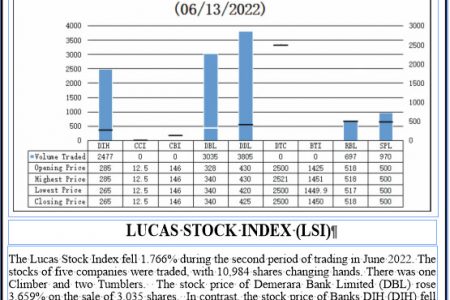
NRGI (and EITI) reporting on the way forward
Introduction Today’s column wraps-up my highlighting of the role of governance of Guyana’s emerging oil and gas sector as an indicator of its prevailing condition.

Introduction Today’s column wraps-up my highlighting of the role of governance of Guyana’s emerging oil and gas sector as an indicator of its prevailing condition.

Introduction Today’s column begins with my wrap-up of last week’s column.

Introduction Today’s column has two aims. First, wrapping up my appraisal of the TIGI’s assertion that granting licences for 317 blocks, instead of 60 blocks, as the PSA requires, has had catastrophic domino consequences for Guyana’s emerging oil and gas sector.

Introduction Today’s column addresses three tasks. First, wrapping-up last week’s evaluation of National Budgets [2021/ 2022] as providers of Government of Guyana, GoG, indicators on the condition of Guyana’s oil and gas sector.

Introduction Thus far I have considered four of the ten sample indicators, which I had earlier advanced can provide an adequate profile of the present condition of Guyana’s emergent oil and gas sector: namely 1) existential threats, Venezuelan territorial aggression and environmental catastrophe; 2) modelled cost shares for crude oil production; 3) oil price projection; and 4) the World Bank’s call on Guyana’s boom cycle.

Introduction Today’s column presents brief commentary on three topics; namely, 1] the estimated break-even prices for Guyana’s crude 2] likely Brent crude oil price going forward, and 3] the World Bank’s prediction of a Guyana “boom cycle” going forward.

Introduction Today’s column continues the coverage of my linking of the theoretical analysis; that is Pillars A B completed so far and policy formulation for the sector, to come.

Introduction This week’s column and the ones immediately following are devoted to linking the two areas into which I have codified my presentation thus far.

Introduction Today’s column starts with a brief acknowledgement of my completion of the indicated “considered critique” of ExxonMobil’s performance in relation to global climate change and energy transition.

Introduction Today’s column addresses the fourth and final focus area for my critique of ExxonMobil’s actions in regard to the transition away from policies that reinforce global warming, climate change, and in support of primary reliance on clean energy technologies in an environmentally-friendly energy mix.
Introduction Today’s column addresses the second and third focus areas of my present critique of ExxonMobil.

Last week’s column represents an earnest effort on my part, to portray, largely in its own words, ExxonMobil’s official posture on global climate change and the energy transition away from fossil fuels usage.
Introduction In last week’s column, I had focused on those reputational risks which confront ExxonMobil, and are not risks directly arising from its performance in regard to global climate change and energy transition.

Introduction Today’s column brings together the manifest debt deformations of ExxonMobil [its zombification] on the one hand; and other deformations more directly related to the firm’s culture, its management performance, social and cultural interactions in the wider society, and consequently its reputational risk exposure.

Introduction Today’s column wraps-up my evaluation of whether the assertion can be plausibly sustained that Guyana’s rapidly emergent oil and gas sector has dramatically improved the fortunes of ExxonMobil going forward.

Introduction A month ago, in my February 13 column, I had readily acknowledged my strong support for the widely expressed judgment that “ExxonMobil in the second half of the 2010s and certainly all of 2020, had become a classic zombie firm, as that term is defined… in business, finance and economics” I used the preceding month to evaluate whether a turnaround away from this zombie status was likely; beginning in Q4 2021.

Introduction My two immediately preceding columns have been dedicated to exploring, for reader’s benefit the thesis advanced by Envision Research, which argues that, ExxonMobil, an iconic Global 500 corporation, can successfully turnaround its fortunes away from its heavy indebtedness and ongoing zombification – if it could arrive at a financial position where it is able to generate sufficient revenues to be able to invest in its own self-driven or organic growth.

Introduction Today’s column continues with a presentation of Envision Research’s modelling of ExxonMobil’s seeming turnaround away from the process of zombification, as I have explained this term.

Introduction As indicated last week, because of space constraints, this week’s column begins with my introduction of a Schedule that I could not have presented then.

Introduction Today’s column treats with my support for the well-sustained assertion to the effect that ExxonMobil, in the second half of the 2010s and certainly all of 2020, had become a classic zombie firm, as defined in last week’s column as a business, finance and economics concept.
The ePaper edition, on the Web & in stores for Android, iPhone & iPad.
Included free with your web subscription. Learn more.